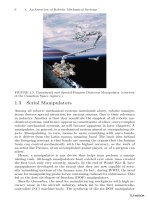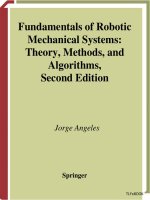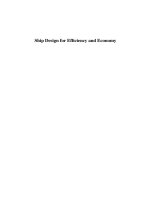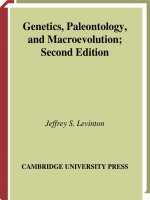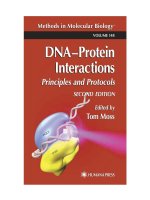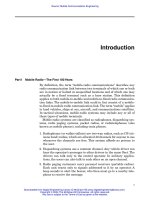Electrical Power Equipment Maintenance and Testing Second Edition By Paul Gill
Bạn đang xem bản rút gọn của tài liệu. Xem và tải ngay bản đầy đủ của tài liệu tại đây (9.82 MB, 1,002 trang )
www.TechnicalBooksPdf.com
POWER ENGINEERING
Series Editor
H. Lee Willis
Quanta Technology
Raleigh, North Carolina
Advisory Editor
Muhammad H. Rashid
University of West Florida
Pensacola, Florida
1. Power Distribution Planning Reference Book, H. Lee Willis
2. Transmission Network Protection: Theory and Practice,
Y. G. Paithankar
3. Electrical Insulation in Power Systems, N. H. Malik,
A. A. Al-Arainy, and M. I. Qureshi
4. Electrical Power Equipment Maintenance and Testing,
Paul Gill
5. Protective Relaying: Principles and Applications,
Second Edition, J. Lewis Blackburn
6. Understanding Electric Utilities and De-Regulation,
Lorrin Philipson and H. Lee Willis
7. Electrical Power Cable Engineering, William A. Thue
8. Electric Systems, Dynamics, and Stability with Artificial
Intelligence Applications, James A. Momoh
and Mohamed E. El-Hawary
9. Insulation Coordination for Power Systems,
Andrew R. Hileman
10. Distributed Power Generation: Planning and Evaluation,
H. Lee Willis and Walter G. Scott
11. Electric Power System Applications of Optimization,
James A. Momoh
12. Aging Power Delivery Infrastructures, H. Lee Willis,
Gregory V. Welch, and Randall R. Schrieber
13. Restructured Electrical Power Systems: Operation, Trading,
and Volatility, Mohammad Shahidehpour
and Muwaffaq Alomoush
14. Electric Power Distribution Reliability, Richard E. Brown
15. Computer-Aided Power System Analysis,
Ramasamy Natarajan
www.TechnicalBooksPdf.com
DK4058_C000.indd i
11/20/2008 10:17:56 AM
16. Power System Analysis: Short-Circuit Load Flow
and Harmonics, J. C. Das
17. Power Transformers: Principles and Applications,
John J. Winders, Jr.
18. Spatial Electric Load Forecasting: Second Edition,
Revised and Expanded, H. Lee Willis
19. Dielectrics in Electric Fields, Gorur G. Raju
20. Protection Devices and Systems for High-Voltage
Applications, Vladimir Gurevich
21. Electrical Power Cable Engineering, Second Edition,
William Thue
22. Vehicular Electric Power Systems: Land, Sea, Air,
and Space Vehicles, Ali Emadi, Mehrdad Ehsani,
and John Miller
23. Power Distribution Planning Reference Book,
Second Edition, H. Lee Willis
24. Power System State Estimation: Theory and
Implementation, Ali Abur
25. Transformer Engineering: Design and Practice,
S.V. Kulkarni and S. A. Khaparde
26. Power System Capacitors, Ramasamy Natarajan
27. Understanding Electric Utilities and De-regulation:
Second Edition, Lorrin Philipson and H. Lee Willis
28. Control and Automation of Electric Power Distribution
Systems, James Northcote-Green and Robert G. Wilson
29. Protective Relaying for Power Generation Systems,
Donald Reimert
30. Protective Relaying: Principles and Applications,
Third Edition, J. Lewis Blackburn and Thomas J. Domin
31. Electric Power Distribution Reliability, Second Edition,
Richard E. Brown
32. Electrical Power Equipment Maintenance and Testing,
Second Edition, Paul Gill
www.TechnicalBooksPdf.com
DK4058_C000.indd ii
11/20/2008 10:17:57 AM
ELECTRICAL POWER
EQUIPMENT
MAINTENANCE
AND TESTING
SECOND EDITION
Paul Gill
Boca Raton London New York
CRC Press is an imprint of the
Taylor & Francis Group, an informa business
www.TechnicalBooksPdf.com
DK4058_C000.indd iii
11/20/2008 10:17:57 AM
CRC Press
Taylor & Francis Group
6000 Broken Sound Parkway NW, Suite 300
Boca Raton, FL 33487-2742
© 2009 by Taylor & Francis Group, LLC
CRC Press is an imprint of Taylor & Francis Group, an Informa business
No claim to original U.S. Government works
Printed in the United States of America on acid-free paper
10 9 8 7 6 5 4 3 2 1
International Standard Book Number-13: 978-1-57444-656-2 (Hardcover)
This book contains information obtained from authentic and highly regarded sources. Reasonable efforts have been
made to publish reliable data and information, but the author and publisher cannot assume responsibility for the validity of all materials or the consequences of their use. The authors and publishers have attempted to trace the copyright
holders of all material reproduced in this publication and apologize to copyright holders if permission to publish in this
form has not been obtained. If any copyright material has not been acknowledged please write and let us know so we may
rectify in any future reprint.
Except as permitted under U.S. Copyright Law, no part of this book may be reprinted, reproduced, transmitted, or utilized in any form by any electronic, mechanical, or other means, now known or hereafter invented, including photocopying, microfilming, and recording, or in any information storage or retrieval system, without written permission from the
publishers.
For permission to photocopy or use material electronically from this work, please access www.copyright.com (http://
www.copyright.com/) or contact the Copyright Clearance Center, Inc. (CCC), 222 Rosewood Drive, Danvers, MA 01923,
978-750-8400. CCC is a not-for-profit organization that provides licenses and registration for a variety of users. For organizations that have been granted a photocopy license by the CCC, a separate system of payment has been arranged.
Trademark Notice: Product or corporate names may be trademarks or registered trademarks, and are used only for
identification and explanation without intent to infringe.
Library of Congress Cataloging-in-Publication Data
Gill, Paul, 1942Electrical power equipment maintenance and testing / Paul Gill. -- 2nd ed.
p. cm.
ISBN 978-1-57444-656-2 (alk. paper)
1. Electric power systems--Testing. 2. Electric power systems--Maintenance and repair. I. Title.
TK401.G55 2008
621.31’0420287--dc22
2008029371
Visit the Taylor & Francis Web site at
and the CRC Press Web site at
www.TechnicalBooksPdf.com
DK4058_C000.indd iv
11/20/2008 10:17:57 AM
Liability
This textbook and instructions offered in it are designed to acquaint students
and readers with accepted good practice for maintenance, operation, and
testing of electrical equipment and/or systems. This book does not purport
to be complete nor is it intended to be specific for the products of any manufacturer, testing procedures, or maintenance routines. The publisher, the
author, companies, and other organizations referenced in this book will not
accept any responsibility and liability whatsoever for work undertaken on
the basis of this text. The sole purpose of this book is to impart knowledge
on the subjects covered in the book. All work undertaken based on this text
is the sole responsibility of the reader and user of the book. The manufacturer’s operating, maintenance, and testing procedures are the only reliable
guide in any specific instance and, therefore, they should be consulted before
undertaking any work on electrical equipment.
The contents of this book do not represent a U.S. Nuclear Regulatory
Commission (USNRC) position on the subjects covered in the book.
v
www.TechnicalBooksPdf.com
DK4058_C000.indd v
11/20/2008 10:17:57 AM
www.TechnicalBooksPdf.com
DK4058_C000.indd vi
11/20/2008 10:17:57 AM
Dedication
In memory of my parents—Jasbir Singh and Amar Kaur
To my wife Patricia—for her patience and understanding to make
this work possible
To my children/spouses—Shaun/Debra, Rajan/Larie, Jason/Deanna, and
Rania/Alden and to my beautiful grandchildren Collin, Andrew, Ryan,
Timothy, Owen, Henry, Jack, Maya, Chani, Paul, and Lauryn
who keep me young and bring boundless joy to my journey in life
www.TechnicalBooksPdf.com
DK4058_C000.indd vii
11/20/2008 10:17:57 AM
www.TechnicalBooksPdf.com
DK4058_C000.indd viii
11/20/2008 10:17:57 AM
Contents
Series Introduction ..................................................................................xxix
Foreword .................................................................................................xxxi
Preface .................................................................................................. xxxiii
Acknowledgments .............................................................................. xxxvii
Chapter 1
Maintenance Strategies, Dielectric Theory,
Insulating Materials, Failure Modes,
and Maintenance Impact on Arc-Flash Hazards
1.1 Introduction ...........................................................................................1
1.2 Why Maintain and Test .......................................................................1
1.3 Overview of Electrical Maintenance and Testing Strategies .........2
1.3.1 Key Factors in EPM Optimization Decisions ...................... 12
1.3.2 General Criteria for an Effective EPM
and Testing Program............................................................... 12
1.3.3 Qualifications of EPM Personnel .......................................... 13
1.3.4 Optimization of PM Intervals ............................................... 14
1.3.5 Trending of Test Results......................................................... 15
1.3.6 Systematic Failure Analysis Approach ................................ 15
1.3.6.1 Postmaintenance Testing ......................................... 16
1.3.6.2 Engineering Support ................................................ 16
1.3.6.3 Summary.................................................................... 17
1.4 Planning an EPM Program ............................................................... 18
1.4.1 Maintenance Management Considerations......................... 18
1.4.1.1 Responsibilities .......................................................... 19
1.4.1.2 Inspection ................................................................... 19
1.4.1.3 Scheduling.................................................................. 19
1.4.1.4 Work Orders ............................................................... 20
1.4.1.5 Record Keeping ......................................................... 20
1.4.2 Technical Requirements ......................................................... 20
1.4.2.1 Survey of Plant Equipment ...................................... 20
1.4.2.2 Listing of Plant Equipment in the Order
of Critical Importance .............................................. 23
1.4.2.3 Plan to Perform EPM on Regular Frequency........ 24
1.4.2.4 Development of Instruction and Procedures
for the EPM Program................................................ 24
1.4.3 What Should Be Included in the EPM Program ................. 25
1.4.3.1 EPM and Testing ....................................................... 25
1.4.3.2 Electrical Repairs ...................................................... 25
1.4.3.3 Analysis of Failures .................................................. 25
1.4.3.4 Trending of Maintenance and Testing Data......... 26
1.4.3.5 Computerized Maintenance
Management System ................................................ 26
ix
www.TechnicalBooksPdf.com
DK4058_C000.indd ix
11/20/2008 10:17:57 AM
Contents
x
1.5 Overview of Testing and Test Methods .......................................... 28
1.5.1 Types of Tests ........................................................................... 28
1.5.1.1 Acceptance Tests ........................................................ 28
1.5.1.2 Routine Maintenance Tests ...................................... 28
1.5.1.3 Special Maintenance Tests ....................................... 29
1.5.2 Types of Testing Methods ...................................................... 29
1.5.2.1 Solid Insulation Testing ........................................... 29
1.5.2.2 Insulating Liquid Testing ........................................ 30
1.5.2.3 Protective Device Testing ........................................30
1.5.2.4 Circuit Breaker Time–Travel Analysis ................... 31
1.5.2.5 Grounding Electrode
Resistance Testing ..................................................... 31
1.5.2.6 Fault Gas Analysis Testing ...................................... 31
1.5.2.7 Infrared Inspection Testing ..................................... 32
1.6 Review of Dielectric Theory and Practice ....................................... 32
1.6.1 Characteristics of Dielectrics (Insulation) ...........................34
1.6.1.1 Dielectric Loss ............................................................ 35
1.6.1.2 PF and DF ................................................................... 35
1.6.1.3 Capacitance ................................................................ 35
1.6.2 Insulation as a Capacitor........................................................ 36
1.6.3 DC Voltage versus AC Voltage Tests .................................... 37
1.6.3.1 DC Voltage Tests........................................................ 38
1.6.3.2 AC Voltage Tests ........................................................ 38
1.6.4 Insulation Breakdown Modes ............................................... 39
1.7 Insulating Materials for Electrical
Power Equipment ................................................................................ 40
1.7.1 Rigid Laminates Sheet, Rod, and Tube................................. 41
1.7.2 Glass Polyester Products ........................................................ 41
1.7.3 Flexible Laminates and Films ................................................ 41
1.7.4 Insulation Temperature Ratings ............................................ 46
1.8 Causes of Insulation Degradation and Failure Modes
of Electrical Equipment ..................................................................... 47
1.8.1 Failure Modes—Electrical Power Equipment ..................... 51
1.8.1.1 Transformers .............................................................. 51
1.8.1.2 Switchgear and Circuit Breakers ............................ 56
1.8.1.3 Relays ..........................................................................64
1.8.1.4 Switchgear Buses .......................................................65
1.8.1.5 Cables and Connectors ............................................. 69
1.8.1.6 Rotating Machines .................................................... 71
1.9 Maintenance of Protective Devices and their Impact
on Arc-Flash Hazard Analysis ......................................................... 81
1.9.1 Bases of Maintenance and Testing
of Protective Devices ............................................................... 81
1.9.2 Failure Statistics ....................................................................... 91
1.9.3 Flash Hazard Analysis ........................................................... 92
www.TechnicalBooksPdf.com
DK4058_C000.indd x
11/20/2008 10:17:57 AM
Contents
xi
Chapter 2
2.1
2.2
2.3
2.4
2.5
2.6
2.7
2.8
Direct-Current Voltage Testing
of Electrical Equipment
Introduction ......................................................................................... 97
DC Voltage Testing of Insulation ..................................................... 98
2.2.1 Dielectric Phenomena and Polarization ............................ 100
2.2.2 Advantages and Disadvantages of DC
Voltage Testing ...................................................................... 101
2.2.2.1 Advantages.............................................................. 101
2.2.2.2 Disadvantages ........................................................ 102
DC Testing Methods ........................................................................ 102
2.3.1 Insulation Resistance Testing .............................................. 102
2.3.1.1 Short-Time Readings .............................................. 103
2.3.1.2 Time–Resistance Readings .................................... 103
2.3.1.3 PI Test ....................................................................... 105
2.3.1.4 Step-Voltage Readings
(DC Voltage Tip-Up Test) ....................................... 105
2.3.2 High-Potential Voltage Test ................................................. 105
Transformers ..................................................................................... 106
2.4.1 Insulation Resistance Measurement .................................. 106
2.4.2 Dielectric Absorption Test ................................................... 110
2.4.3 DC High-Potential Test ........................................................ 111
Cables and Accessories .................................................................... 113
2.5.1 Insulation Resistance Measurement Test .......................... 113
2.5.2 DC Overpotential Testing.................................................... 117
2.5.3 Voltage versus Leakage Current Test
(Step-Voltage Test).................................................................. 119
2.5.4 Leakage Current versus Time Test ..................................... 121
2.5.5 Go, No-Go Overpotential Test ............................................ 121
2.5.6 DC Overpotential Test Connections and Procedures ..... 121
Electrical Switchgear and Circuit Breakers .................................. 124
2.6.1 Insulation Resistance Measurement Test .......................... 124
2.6.2 DC High-Potential Test ........................................................ 126
2.6.3 Circuit Breaker Contact Resistance Measurement Test... 127
Motors and Generators .................................................................... 127
2.7.1 Insulation Resistance Test .................................................... 128
2.7.1.1 Field-Winding Test Procedures ............................. 128
2.7.1.2 Overall Stator (Armature Windings) Test ........... 129
2.7.1.3 Overall System Test for the
Motor or Generator................................................. 130
2.7.1.4 Individual Stator Winding Test............................. 130
2.7.2 DC Overpotential Test .......................................................... 133
2.7.3 Voltage versus Leakage Current Test
(Step-Voltage Test).................................................................. 133
2.7.4 Leakage Current versus Time Test ..................................... 134
Lightning Arresters .......................................................................... 136
www.TechnicalBooksPdf.com
DK4058_C000.indd xi
11/20/2008 10:17:57 AM
Contents
xii
2.9
Capacitors ........................................................................................ 137
2.9.1 Tests to Check the Condition of New Capacitor
Units before Placing in Service ....................................... 137
2.9.2 Tests to Check the Condition of a Capacitor Unit
after It Has Been in Service ............................................. 137
2.10 Evaluation of Test Data Readings ................................................. 139
2.10.1 Acceptance Criteria for Rating Insulation ..................... 140
2.11 Precautions When Making DC Tests ........................................... 143
Chapter 3 Power Factor and Dissipation Factor Testing Methods
3.1
Introduction ..................................................................................... 145
3.2
PF and DF Test Methods................................................................ 146
3.2.1 General ................................................................................ 146
3.2.2 Principles of PF/DF Testing ............................................. 147
3.2.3 Factors That Influence PF Measurements ...................... 148
3.3 Description of the PF Test Equipment ......................................... 149
3.3.1 PF and DF Test Set ............................................................. 149
3.3.2 General Instructions for the Operation
of the Megger Test Set ....................................................... 152
3.3.3 Doble PF Test Set ............................................................... 153
3.3.4 Operation of Doble PF Test Set ........................................ 153
3.4 Basic Test Connections (Test Modes) for PF Testing .................. 154
3.4.1 Grounded-Specimen Test Mode ...................................... 154
3.4.2 GST Mode with Guard (GST-G) ...................................... 154
3.4.3 Ungrounded-Specimen Test Mode ................................. 155
3.5
Safety Cautions with PF Testing .................................................. 155
3.6 PF Testing of Electrical Apparatus Insulation ............................ 157
3.6.1 Transformers ...................................................................... 158
3.6.1.1 Two-Winding Transformers .............................. 158
3.6.1.2 Three-Winding Transformers ........................... 161
3.6.1.3 Autotransformers................................................ 163
3.6.1.4 PTs ......................................................................... 163
3.6.2 Transformer Bushing ........................................................ 164
3.6.2.1 Hot-Collar Tests of Noncondenser-Type
Bushings ............................................................... 167
3.6.3 Transformer Excitation Current Test .............................. 168
3.6.4 Transformer Insulating Oils and Fluids ........................ 170
3.6.5 Lightning Arrestors .......................................................... 171
3.6.6 Circuit Breakers ................................................................. 171
3.6.6.1 Medium-Voltage Circuit Breakers .................... 172
3.6.6.2 Oil Circuit Breakers (OCBs)............................... 173
3.6.7 SF6 Breaker .......................................................................... 177
3.6.8 Rotating Machinery .......................................................... 177
3.6.8.1 PF Tip-Up Test ..................................................... 178
3.6.9 Cables and Accessories ..................................................... 180
3.6.9.1 Shielded or Sheathed Cable ............................... 181
3.6.9.2 Unshielded and Unsheathed Cables ................ 181
www.TechnicalBooksPdf.com
DK4058_C000.indd xii
11/20/2008 10:17:57 AM
Contents
xiii
3.6.10 PF Correction Capacitors and Surge Capacitors ............. 182
3.6.10.1 Bus Insulators....................................................... 183
3.6.10.2 Miscellaneous Equipment.................................. 183
3.7 Evaluation and Grading of PF
and DF Test Results .......................................................................... 184
3.7.1
General .................................................................................. 184
3.7.2
Analysis of the Results ....................................................... 185
3.7.2.1
Transformers ........................................................ 185
3.7.2.2 Bushings ............................................................... 187
3.7.2.3
Lightning and Surge Arrestors ......................... 188
3.7.2.4
Medium-Voltage Circuit Breakers..................... 188
3.7.2.5
OCB ....................................................................... 189
3.7.2.6 SF6 Breakers .......................................................... 189
3.7.2.7
Rotating Machines .............................................. 190
3.7.2.8 Cables and Accessories....................................... 190
3.7.2.9
Capacitors ............................................................. 190
Chapter 4 Insulating Oils, Fluids, and Gases
4.1 Introduction ....................................................................................... 193
4.2 Insulating Oil .................................................................................... 193
4.2.1 Deterioration of Insulating Oil .......................................... 194
4.2.1.1 Effect of Oxygen on Oil ...................................... 194
4.2.1.2
Moisture in Oil .................................................... 194
4.2.1.3 Oil Deterioration in Transformers .................... 195
4.2.1.4 Absorption of Moisture by
Insulating Materials ........................................... 196
4.2.1.5 Absorption of Nitrogen by Oil .......................... 196
4.2.2 Insulating Oil Testing ......................................................... 196
4.2.2.1 Dielectric Breakdown
Voltage Test (Cup Tests) ...................................... 197
4.2.2.2 Acidity Test ........................................................... 200
4.2.2.3 Interfacial Tension (IFT) ..................................... 201
4.2.2.4 Color Test .............................................................. 201
4.2.2.5 Power Factor Test ................................................. 201
4.2.2.6 Specific Gravity .................................................... 202
4.2.2.7 Water Content Test (Karl Fisher Method) ........ 202
4.2.3 Combustible Gas Analysis of Insulating Oil ................... 203
4.2.3.1 Introduction .......................................................... 203
4.2.3.2 TCG ........................................................................ 203
4.2.3.3 DGA ....................................................................... 204
4.2.3.4 Comparing the Two Methods ............................ 204
4.2.3.5 Interpretation of Gas Analysis........................... 204
4.2.3.6 Assessing the Transformer Condition
Using the TCGA in the Gas Space .................... 206
4.2.3.7 Assessing the Transformer Condition
Using the DGA Method...................................... 207
4.2.3.8 Fault Types and Associated Key Gases ............ 208
www.TechnicalBooksPdf.com
DK4058_C000.indd xiii
11/20/2008 10:17:57 AM
Contents
xiv
4.3 Less Flammable Insulating Fluids ................................................. 209
4.4 Insulating Liquid Sampling Procedures ....................................... 210
4.4.1 Sampling Oil from Transformers........................................ 211
4.4.2 Sampling Oil from Drums
or Shipping Containers ........................................................ 211
4.4.3 Taking Oil Samples for Gas-in-Oil Analysis .................... 212
4.5 Maintenance and Reconditioning of Insulating
Oil and Fluids .................................................................................... 212
4.5.1 Reconditioning Used Insulating Oils ................................ 213
4.5.1.1 Natural Precipitation .............................................. 213
4.5.1.2 Filter Presses............................................................ 214
4.5.1.3 Filter Press Operation ............................................ 215
4.5.1.4 Cartridge Filters ...................................................... 215
4.5.1.5 Centrifuges .............................................................. 215
4.5.1.6 Coalescers ................................................................ 217
4.5.1.7 Vacuum Dehydrators ............................................. 217
4.5.2 Maintenance of Less Flammable Fluids ............................ 217
4.5.2.1 Maintenance of RTemp .......................................... 217
4.5.2.2 Maintenance of Silicone ........................................ 218
4.5.2.3 Maintenance of Wecosol ....................................... 220
4.5.2.4 Maintenance of Environtemp (FR3) .................... 223
4.5.2.5 Maintenance of Askarels ...................................... 227
4.6 Insulating Gases ............................................................................... 231
4.6.1 Maintenance of SF6................................................................ 231
4.6.1.1 Conducting Particles .............................................. 231
4.6.1.2 Moisture ................................................................... 232
4.6.1.3 Oil Contamination.................................................. 232
4.6.1.4 Gaseous Contamination ........................................ 233
4.6.1.5 Arc Products ............................................................ 233
Chapter 5 Transformers
5.1 Introduction ....................................................................................... 235
5.2 Transformer Categories and Type .................................................. 235
5.2.1 Insulating Medium ............................................................... 235
5.2.1.1 Dry Type .................................................................. 236
5.2.1.2 Liquid-Filled Transformer ..................................... 236
5.2.2 Construction .......................................................................... 237
5.2.2.1 Tank Construction.................................................. 237
5.2.2.2 Core Construction .................................................. 238
5.3 Application and Use ......................................................................... 238
5.3.1 Distribution Transformers ................................................... 238
5.3.2 Network Transformer........................................................... 239
5.3.3 Arc-Furnace Transformer .................................................... 239
5.3.4 Rectifier Transformer............................................................ 240
5.3.5 Power Transformer ............................................................... 240
5.4 Transformer Fundamentals............................................................. 240
www.TechnicalBooksPdf.com
DK4058_C000.indd xiv
11/20/2008 10:17:57 AM
Contents
5.5
5.6
5.7
5.8
xv
5.4.1 Voltage Relationship ............................................................. 244
5.4.2 Current Relationship ............................................................ 244
5.4.3 Impedance Relationship ...................................................... 244
5.4.4 Summary................................................................................ 245
Transformer Polarity, Terminal Markings,
and Connections ............................................................................... 246
5.5.1 Single-Phase Transformers .................................................. 246
5.5.1.1 Subtractive Polarity ................................................. 246
5.5.1.2 Additive Polarity ..................................................... 247
5.5.2 Three-Phase Transformers .................................................. 247
Transformer Characteristics ............................................................ 250
Preventive Maintenance of Transformers ..................................... 253
5.7.1 Transformer Installation, Acceptance,
and Maintenance ..................................................................254
5.7.1.1 Unscheduled Maintenance ....................................254
5.7.1.2 Ordinary Maintenance ...........................................254
5.7.1.3 Protective Maintenance ..........................................254
5.7.2 Dry-Type Transformers ........................................................ 255
5.7.2.1 Installation ............................................................... 255
5.7.2.2 Inspection ................................................................. 257
5.7.2.3 Acceptance Tests...................................................... 258
5.7.2.4 Maintenance............................................................. 260
5.7.2.5 Drying-Out Methods .............................................. 261
5.7.2.6 Storage....................................................................... 263
5.7.3 Liquid-Type Transformer ..................................................... 263
5.7.3.1 Installation ............................................................... 263
5.7.3.2 Inspection ................................................................. 265
5.7.3.3 Acceptance Tests...................................................... 265
5.7.3.4 Maintenance............................................................. 267
5.7.3.5 Drying-Out Methods .............................................. 271
5.7.3.6 Storage....................................................................... 273
5.7.3.7 Transformer Diagnostic Guide .............................. 273
Transformer Testing ......................................................................... 275
5.8.1 AC Hi-Pot Test ....................................................................... 276
5.8.2 TTR Test.................................................................................. 276
5.8.2.1 Alternative Test for TTR ......................................... 279
5.8.2.2 TTR Capacitor .......................................................... 280
5.8.3 Polarity Test ........................................................................... 281
5.8.4 Induced Potential Test .......................................................... 281
5.8.5 FRA ......................................................................................... 282
5.8.6 DC Winding Resistance ....................................................... 285
5.8.7 Transformer Core Ground Test ........................................... 286
5.8.8 Polarization Recovery Voltage Test .................................... 286
5.8.8.1 The Measuring Instrument.................................... 287
5.8.8.2 Test Setup for Recovery Voltage Measurement
on Power Transformers .......................................... 288
www.TechnicalBooksPdf.com
DK4058_C000.indd xv
11/20/2008 10:17:57 AM
Contents
xvi
5.8.8.3
Evaluation of Measured
Polarization Spectra .......................................... 290
5.9 Online Condition Monitoring of Transformers.......................... 291
5.9.1
Online Monitoring of Transformers ............................... 292
5.10 Online Monitoring of Bushings and Lightning Arrestors........ 296
Chapter 6 Cables and Accessories
6.1 Introduction ..................................................................................... 299
6.2 Cable Construction and Classification......................................... 299
6.2.1 Types of Conductors ..........................................................300
6.2.2 Conductor Arrangement ................................................... 301
6.2.3 Cable Types ......................................................................... 301
6.2.4 Insulations........................................................................... 302
6.2.5 Shielding and Semiconducting Tape...............................305
6.2.6 Finishes and Jackets ...........................................................306
6.2.7 Cable Construction ............................................................ 307
6.3 Cable Characteristics ......................................................................308
6.4 Electrical Constants ........................................................................ 312
6.5 Cable Ratings ................................................................................... 314
6.6 Cable Selection and Application ................................................... 317
6.7 Installation of Cables ...................................................................... 322
6.7.1
Outdoor Installations ........................................................ 322
6.7.2
Indoor Installations ........................................................... 323
6.7.3 Bending Data ...................................................................... 323
6.7.4
Pulling Tensions................................................................. 323
6.8 Maintenance of Cables ................................................................... 325
6.9 Cable Failures and Their Analysis ............................................... 326
6.10 Field Testing of Medium-Voltage Cables ..................................... 330
6.10.1 Cable Degradation and Diagnostic Tests ....................... 330
6.10.2 Safety Practices and Grounding ......................................334
6.10.3 Cable Testing Methods ..................................................... 335
6.10.3.1 Insulation Resistance and DC
Hi-Pot Testing..................................................... 335
6.10.3.2 AC Hi-Pot Testing .............................................. 336
6.10.3.3 PF and DF Testing ............................................. 337
6.10.3.4 VLF Tests............................................................. 338
6.10.3.5 PD Test ................................................................ 341
6.10.3.6 AC Resonance Test ............................................346
6.10.3.7 Summary of Testing Methods .........................348
6.11 Latest Trends in Cable Condition Monitoring
and Aging Assessment................................................................... 352
6.11.1 Electronic Characterization and
®
Diagnostic (ECAD ) System ............................................ 352
6.11.2 Cable Indentor .................................................................... 352
6.11.3 Oscillating Wave (OSW) Testing ..................................... 353
www.TechnicalBooksPdf.com
DK4058_C000.indd xvi
11/20/2008 10:17:58 AM
Contents
xvii
6.11.4
Broadband Impedance Spectroscopy
Prognostic/Diagnostic Technique ..................................354
6.12 Cable Fault Locating Methods ...................................................... 356
6.12.1 Terminal Techniques ........................................................ 356
6.12.2 Tracer Techniques ............................................................. 362
6.12.3 Application Guide for Cable Fault Locating ................. 367
Chapter 7
7.1
7.2
7.3
7.4
7.5
7.6
Medium-Voltage Switchgear
and Circuit Breakers
General.............................................................................................. 377
Medium-Voltage Switchgear ......................................................... 377
7.2.1
Construction Features ...................................................... 377
7.2.1.1 Metal-Clad Switchgear ....................................... 378
7.2.1.2 Metal-Enclosed Interrupter Switchgear ........... 382
7.2.1.3 Station-Type Cubicle ........................................... 382
7.2.2 Short-Circuit Considerations and Power Circuit
Breaker Ratings .................................................................. 383
7.2.3 Selection and Application of Power
Circuit Breakers ................................................................. 392
Electrical Switchgear Maintenance and Care ............................. 393
7.3.1
MV Switchgear................................................................... 393
7.3.1.1 Power Circuit Breakers ....................................... 393
7.3.1.2 Maintenance ........................................................ 395
7.3.2
Air-Magnetic Circuit Breakers ........................................ 396
7.3.3 Oil Circuit Breaker ............................................................ 398
7.3.4
Vacuum Circuit Breaker ................................................... 399
7.3.5 Switchgear Enclosure and Bus ........................................400
Electrical Switchgear Testing ........................................................ 403
7.4.1
Insulation Resistance Measurement Test ....................... 403
7.4.2
DC Hi-Pot Test ...................................................................405
7.4.3
AC Hi-Pot Test....................................................................405
7.4.4
Power Factor Testing ......................................................... 407
7.4.5
Circuit Breaker Contact Resistance
Measurement Test.............................................................. 407
7.4.6 Circuit Breaker Time–Travel Analysis............................ 407
7.4.7
Dynamic Capacitance Measurement of HV Breaker ... 413
Control Power for Switchgear ....................................................... 415
7.5.1
Control Power Requirements........................................... 415
7.5.1.1 Circuit Breaker Tripping .................................... 416
7.5.1.2 DC Battery Trip ................................................... 416
7.5.1.3 Capacitor Trip ...................................................... 416
7.5.1.4 AC Methods of Tripping .................................... 418
7.5.1.5 Circuit Breaker Closing ...................................... 418
DC (Battery) Control Power Equipment ...................................... 420
7.6.1 Sizing .................................................................................... 420
www.TechnicalBooksPdf.com
DK4058_C000.indd xvii
11/20/2008 10:17:58 AM
Contents
xviii
7.6.2 Types of Batteries .................................................................. 421
7.6.3 Battery Chargers ...................................................................422
7.7 AC Control Power Equipment.........................................................422
7.7.1 Sizing ......................................................................................422
7.7.2 Application ............................................................................423
7.8 Maintenance and Care of Batteries
for Switchgear Applications ............................................................423
7.8.1 Inspections.............................................................................423
7.8.2 Equalizing Charge ................................................................ 424
7.8.3 Battery Tests...........................................................................425
7.8.3.1 Acceptance Test ......................................................425
7.8.3.2 Performance Test ....................................................425
7.8.3.3 Battery Service Test (Load Test)............................ 426
7.8.3.4 Connection Resistance Test ................................... 427
7.8.3.5 Battery Impedance Test ......................................... 427
7.8.4 Addition of Water ................................................................. 427
7.8.5 Acid Spillage.......................................................................... 428
7.8.6 Loose Connections ............................................................... 429
7.8.7 Corrosion ............................................................................... 429
7.8.9 Other Maintenance Hints .................................................... 429
Chapter 8 Low-Voltage Switchgear and Circuit Breakers
8.1 Low-Voltage Switchgear................................................................... 431
8.2 Low-Voltage Circuit Breakers ......................................................... 432
8.2.1 MCCBs....................................................................................433
8.2.2 Insulated-Case Circuit Breakers .........................................433
8.2.3 Power Circuit Breakers ........................................................433
8.2.4 Fused Power Circuit Breakers.............................................434
8.3 Overcurrent Protective Devices .....................................................434
8.3.1 Direct-Acting Trip.................................................................434
8.3.2 Static- and Electronic-Trip Units ......................................... 435
8.3.3 Monitoring and Protection Packages................................. 439
8.4 Fuses ................................................................................................... 439
8.4.1 Low-Voltage Fuses ................................................................440
8.5 Disconnect Switches......................................................................... 441
8.5.1 Low-Voltage Switches........................................................... 441
8.6 Selection and Application of Low-Voltage Equipment ...............442
8.6.1 Assessing Service Life of Low-Voltage Breakers ..............444
8.6.1.1 Maximum Voltage Rating or Nominal
Voltage Class ...........................................................444
8.6.1.2 Continuous Current Rating ..................................444
8.6.1.3 Rated Short-Circuit Current
(Circuit Breakers) ....................................................445
8.6.1.4 Short-Circuit Current Ratings—Panelboards,
MCCs, and Switchgear Assemblies ..................... 447
8.6.1.5 Endurance Requirements
for Low-Voltage Breakers ......................................448
www.TechnicalBooksPdf.com
DK4058_C000.indd xviii
11/20/2008 10:17:58 AM
Contents
xix
8.7
Low-Voltage Switchgear Maintenance and Care........................ 450
8.7.1
General Guidelines for Inspection and
Maintenance of Switchgear .............................................. 450
8.7.2 Maintenance of Power Circuit Breakers .........................454
8.7.2.1
Mechanical Maintenance Factors ................... 456
8.7.2.2 Electrical Maintenance Factors........................ 458
8.7.2.3 Inspections Procedure ...................................... 459
8.7.3 MCCBs ................................................................................. 460
8.7.3.1
Mechanical Factors............................................ 460
8.7.3.2
Electrical Factors................................................ 462
8.7.3.3
Inspections Procedure ......................................463
8.7.4 Switchgear Enclosure ........................................................ 463
8.7.5 Air Disconnect Switches, Fuses,
and Insulators .....................................................................463
8.7.5.1
Air Disconnect Switches ..................................464
8.7.5.2
Power Fuses........................................................464
8.7.5.3
Insulators ............................................................ 465
8.8 Maintenance and Testing of Low-Voltage
Protective Devices ........................................................................... 465
8.8.1 Power Circuit Breaker Overcurrent
Trip Devices ........................................................................ 466
8.8.1.1
Overcurrent Trip Units ..................................... 466
8.8.2 Molded-Case Breaker Trips .............................................. 470
8.8.2.1 Protective Trip Testing...................................... 471
8.8.2.2 Verification Testing ........................................... 472
8.8.3 Overload Relays ................................................................. 474
8.8.4 Testing of Ground Fault Sensing and Relaying
Equipment ........................................................................... 474
8.8.4.1 Preparation for Fielding Training ................... 475
8.8.4.2 Field Testing ....................................................... 475
8.9 Uninterruptible Power Supply Commissioning
and Testing ....................................................................................... 477
8.9.1 Background ......................................................................... 477
8.9.2 Preinstallation Checks and Tests ..................................... 478
8.9.3 Combined Test (UPS with the Generator) ......................480
8.9.4 Maintenance Test ...............................................................480
8.9.4.1
UPS Battery System...........................................480
8.9.5 Maintenance and Testing.................................................. 486
8.9.6 Summary ............................................................................. 486
8.10 Infrared Inspection of Electrical Equipment .............................. 487
8.10.1 Types of Thermographic Scanners .................................. 487
8.10.2 Conducting an IR Thermographic Inspection .............. 488
8.10.2.1 Delta-T Temperature Rating Systems ............. 488
8.10.2.2 Standards-Based Temperature
Rating System .................................................... 490
8.10.3 Conducting a Thermographic Survey ............................ 493
8.10.4 Examples of Thermographic Findings ............................ 494
www.TechnicalBooksPdf.com
DK4058_C000.indd xix
11/20/2008 10:17:58 AM
Contents
xx
Chapter 9
9.1
9.2
9.3
9.4
9.5
9.6
9.7
9.8
Testing and Commissioning of Protective Relays
and Instrument Transformers
Introduction ....................................................................................... 497
Instrument Transformers ................................................................ 497
9.2.1 Current Transformers ........................................................... 498
9.2.1.1 CT Accuracy Standards ......................................... 499
9.2.1.2 Accuracy Classes for Metering .............................500
9.2.1.3 Accuracy Classes for Relaying ..............................500
9.2.2 Voltage (Potential) Transformers ......................................... 501
9.2.3 Polarity of Instrument Transformers.................................. 502
9.2.3.1 Testing for Polarity of Instrument
Transformers ............................................................ 503
9.2.4 Testing for Ratio of Instrument Transformers ..................504
9.2.5 Winding and Lead Resistance Measurements .................. 507
9.2.6 Burden Measurements.......................................................... 507
9.2.7 CT Remanence ....................................................................... 507
9.2.8 Grounding of CT ...................................................................508
9.2.9 Maintenance and Testing of Instrument
Transformers .......................................................................... 509
Protective Relays ............................................................................... 510
9.3.1 Classification of Relays ......................................................... 510
9.3.2 Overview of Protective Relays—Construction
and Types................................................................................ 510
9.3.2.1 Electromechanical and Induction Relays
(First-Generation Relays) ........................................ 511
9.3.2.2 Static Relays (Second-Generation Relays) ............ 512
9.3.2.3 Solid-Sate Relays (Third-Generation Relays) ...... 513
9.3.2.4 Microprocessor Relays (Fourth-Generation
Relays) ....................................................................... 513
Relay Application and Principles ................................................... 515
Types of Relay Tests.......................................................................... 519
Testing and Maintenance of Electromechanical
Protective Relays ............................................................................... 521
9.6.1 Relay Inspection and Tests................................................... 521
9.6.2 Protective Relay Test Procedures
and Circuits ............................................................................ 524
9.6.3 Relay Test Points and Test Circuits ..................................... 524
9.6.4 Instrument Transformers Calibration ................................ 527
Testing and Commissioning of Static
and Digital Relays ............................................................................ 531
9.7.1 Test Methods .......................................................................... 533
9.7.2 Commissioning Methods .....................................................534
9.7.3 Commissioning Examples ................................................... 536
Event Reporting ................................................................................540
www.TechnicalBooksPdf.com
DK4058_C000.indd xx
11/20/2008 10:17:58 AM
Contents
xxi
Chapter 10 Motors and Generators
10.1 General ............................................................................................. 549
10.2 NEMA Classification of Motors and Generators ....................... 549
10.2.1 According to Size............................................................... 550
10.2.2 According to Application ................................................. 550
10.2.3 According to Electrical Type............................................ 551
10.2.3.1 AC Motors .......................................................... 551
10.2.3.2 Polyphase Motor................................................ 551
10.2.3.3 Single-Phase Motor ........................................... 552
10.2.3.4 Universal Motor................................................. 553
10.2.3.5 DC Motors .......................................................... 553
10.2.3.6 DC Generators ................................................... 554
10.2.4 According to Physical Protection (Enclosure)
and Methods of Cooling ................................................... 554
10.2.5 According to Variability of Speed ................................... 555
10.2.6 Terminal Marking of Machines....................................... 556
10.2.6.1 Single-Voltage Motors ....................................... 557
10.2.6.2 Dual-Voltage Motors ......................................... 557
10.2.6.3 Polyphase Motors .............................................. 557
10.3 Applications of Motors and Generators ...................................... 559
10.3.1 Electrical Integrity ............................................................. 560
10.3.1.1 Dielectric Rating ................................................ 560
10.3.1.2 Load–Time Rating ............................................. 561
10.3.2 Mechanical Integrity ......................................................... 562
10.4 AC Motors ........................................................................................ 562
10.4.1 Environmental Conditions ............................................... 562
10.4.2 Direction of Rotation ......................................................... 563
10.4.3 Operation at Altitudes above 3300 ft............................... 563
10.4.4 Voltage and Frequency ..................................................... 563
10.4.5 Horsepower, Torque, and Speed Considerations.......... 565
10.4.6 Power Factor ....................................................................... 567
10.4.7 Motor Selection .................................................................. 567
10.5 AC Generators ................................................................................. 568
10.5.1 Service Conditions............................................................. 568
10.5.2 Ratings ................................................................................ 569
10.5.3 Temperature Rise ............................................................... 569
10.5.4 Variation in Voltage ........................................................... 570
10.5.5 Regulation .......................................................................... 570
10.6 DC Motors ........................................................................................ 570
10.6.1 Service Conditions............................................................. 570
10.6.2 Operation of DC Motor on Rectified AC........................ 570
10.6.3 Operation of the DC Motor below Base Speed ............. 571
10.6.4 Operation of the DC Motor above Base Speed .............. 571
10.6.5 Overload Capability .......................................................... 571
www.TechnicalBooksPdf.com
DK4058_C000.indd xxi
11/20/2008 10:17:58 AM
Contents
xxii
10.7
DC Generators ................................................................................. 572
10.7.1
Service Conditions ........................................................... 572
10.7.2 Ratings ............................................................................... 572
10.7.3 Temperature Rise ............................................................. 572
10.7.4
Overload Capability......................................................... 572
10.7.5 Voltage Excitation ............................................................. 572
10.7.6
Overspeed ......................................................................... 572
10.8 Motor and Generator Insulation Systems ................................... 572
10.8.1 Machine Insulation System ............................................ 572
10.9 Motor and Generator Maintenance .............................................. 576
10.9.1
Failure Mechanisms ........................................................ 576
10.9.1.1
Stator-Winding Insulation ............................. 576
10.9.1.2 Rotor-Winding Insulation ............................. 577
10.9.1.3 Exciter Insulation ............................................ 577
10.9.2 General Inspection ........................................................... 577
10.9.2.1 Visual Inspection ............................................ 578
10.9.3 DC Motors and Generators and
Repulsion-Induction Motors .......................................... 580
10.9.3.1 Cleanliness ...................................................... 580
10.9.3.2 Armature ......................................................... 581
10.9.3.4 Field Windings ................................................ 587
10.9.4 Induction Motor................................................................ 588
10.9.4.1 Stator Windings .............................................. 589
10.9.4.2 Air Gap............................................................. 589
10.9.4.3 Wound-Rotor Windings ................................ 590
10.9.4.4 Brushes and Rings .......................................... 591
10.9.4.5 Centrifugal Switches ...................................... 591
10.9.4.6 Squirrel-Cage Rotors ...................................... 591
10.9.5 Synchronous Motors and Generators ........................... 592
10.9.6 Cleaning and Varnishing
of Machine Windings ...................................................... 593
10.9.6.1 Cleaning ........................................................... 593
10.9.6.2 Drying .............................................................. 594
10.9.6.3 Varnish ............................................................. 595
10.9.7 Lubrication, Bearings, and Oil Seals ............................. 596
10.9.7.1
Lubrication ....................................................... 596
10.9.7.2
Sleeve Bearings ............................................... 596
10.9.7.3
Antifriction Bearings ..................................... 598
10.9.7.4
Installation of Oil Seals.................................. 599
10.9.8 Brushes ..............................................................................600
10.9.8.1 Brush Adjustment........................................... 601
10.9.9 Balancing ........................................................................... 602
10.9.9.1
Need for Balancing......................................... 603
10.9.9.2 Imbalance Measurement ............................... 603
10.9.10 Belts, Gears, and Pinions................................................. 603
10.9.10.1 Belts................................................................... 603
10.9.10.2 Gears and Pinions ..........................................604
www.TechnicalBooksPdf.com
DK4058_C000.indd xxii
11/20/2008 10:17:58 AM
Contents
xxiii
10.10
Predictive Maintenance Guide on Motors
and Variable Frequency Drives ...................................................604
10.10.1 Power Quality ................................................................. 605
10.10.2 Power Circuit................................................................... 611
10.10.3 Insulation Condition ...................................................... 615
10.10.4 Stator Condition .............................................................. 621
10.10.5 Rotor Condition .............................................................. 625
10.10.6 Air Gap.............................................................................630
10.11 Testing of Motors and Generators ..............................................643
10.11.1 Insulation Resistance and Dielectric
Absorption Tests .............................................................650
10.11.2 High-Potential Test .........................................................650
10.11.3 PF Test .............................................................................. 652
10.11.4 Dissipation Factor Tan d Test ........................................ 653
10.11.5 Partial Discharge Test ....................................................654
10.11.6 Slot Discharge Test ......................................................... 657
10.11.7 Conductor Insulation Tests ........................................... 657
10.11.8 Motor and Generator Component Tests ...................... 657
10.11.9 Voltage Surge Comparison Test ................................... 659
10.12 Other Insulation Test Methods ................................................... 660
10.12.1 Very Low Frequency Testing ........................................ 660
10.12.2 Series Resonant Testing ................................................. 662
10.13 Vibration Analysis ........................................................................ 663
Chapter 11
11.1
11.2
11.3
11.4
Electrical Power System Grounding
and Ground Resistance Measurements
Introduction ................................................................................... 665
Selection of Grounding Method ................................................. 666
11.2.1 Ungrounded Systems .................................................... 666
11.2.2 Solidly Grounded Systems ............................................ 668
11.2.3 Reactance and Resistance Grounded Systems ........... 669
11.2.4 Resonant Grounding...................................................... 672
11.2.5 Grounding Ungrounded Systems ................................ 673
Selection of Grounding System ................................................... 676
11.3.1 Solidly Grounded System.............................................. 677
11.3.2 Low-Resistance Grounding .......................................... 678
11.3.3 High-Resistance Grounding ......................................... 679
11.3.4 Reactance Grounding .................................................... 679
11.3.5 Ground-Fault Neutralizers (Resonant Grounded) .... 679
Understanding Ground Resistance ............................................680
11.4.1 Grounding Electrode Resistance..................................680
11.4.2 Effect of Ground Electrode Size and Depth
on Resistance ................................................................... 682
11.4.3 Effect of Soil Resistivity on Ground
Electrode Resistance.......................................................684
11.4.4 Factors Affecting Soil Resistivity .................................684
11.4.5 Effect of Ground Electrode Depth on Resistance ...... 687
www.TechnicalBooksPdf.com
DK4058_C000.indd xxiii
11/20/2008 10:17:58 AM
Contents
xxiv
11.5
11.6
11.7
Ground Resistance Values ............................................................. 687
Ground Resistance Measurements .............................................. 689
11.6.1 Two-Point Method ............................................................ 689
11.6.2 Three-Point Method ......................................................... 690
11.6.3 Fall-of-Potential Method .................................................. 692
11.6.3.1 Position of the Auxiliary Electrodes
on Measurements.............................................. 693
11.6.3.2 Measuring Resistance of Ground
Electrodes (62% Method) ................................. 694
11.6.3.3 Auxiliary Electrode Spacing ........................... 696
11.6.3.4 Multiple Electrode System ............................... 697
11.6.4 Ratio Method ..................................................................... 700
11.6.5 Soil Resistivity Measurements (Four-Point
Measurement) .................................................................... 701
11.6.6 Touch Potential Measurements ....................................... 702
11.6.7 Clamp-On Ground Resistance Measurement............... 704
11.6.7.1 Principle of Operation ...................................... 704
11.6.7.2 In-Field Measurement ...................................... 705
11.6.7.3 Transmission Towers ........................................ 709
11.6.7.4 Central Office Locations .................................. 710
Ground Grid Integrity Measurements ........................................ 710
Chapter 12
12.1
12.2
12.3
12.4
12.5
Power Quality, Harmonics,
and Predictive Maintenance
Background ..................................................................................... 715
PQ Concept and Fundamentals ................................................... 716
12.2.1 Types and Consequences of Electrical Disturbances .. 717
Origins of PQ Problems and Harmonics .................................... 726
Characteristics of Typical Linear and Nonlinear Loads ........... 729
12.4.1 Voltage and Current Characteristics
of Nonlinear Loads ........................................................... 731
12.4.1.1 HD Terminology ............................................... 731
12.4.1.2 Types of Nonlinear Loads ............................... 732
12.4.1.3 PF Characteristics of Loads ............................. 735
12.4.1.4 Phase Sequence of Harmonics ........................ 739
12.4.1.5 Harmonic Generating Characteristics ........... 742
12.4.1.6 Sensitivity to Harmonics ................................. 742
12.4.1.7 Sensitivity to Voltage Variation ...................... 743
12.4.1.8 Sensitivity to Voltage Flicker........................... 743
12.4.1.9 Sensitivity to Noise........................................... 743
Effects of Harmonic on Power System Equipment
and Loads ........................................................................................ 743
12.5.1 Basic Concepts on Effects of Harmonics ....................... 744
12.5.1.1 Thermal Stress................................................... 745
12.5.1.2 Insulation Stress ................................................ 747
12.5.1.3 Load Disruption ................................................ 747
www.TechnicalBooksPdf.com
DK4058_C000.indd xxiv
11/20/2008 10:17:58 AM
